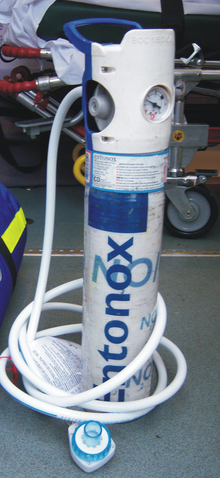User:Mr. Ibrahem/Nitrous oxide (medication)
 Entonox CD cylinder and giving set | |
| Clinical data | |
|---|---|
| Trade names | Entonox, others |
| Pharmacokinetic data | |
| Onset of action | 30 seconds[1] |
| Duration of action | 1 minute[1] |
| Chemical and physical data | |
| Formula | N2O |
| Molar mass | 44.013 g·mol−1 |
| 3D model (JSmol) | |
| |
| |
Nitrous oxide, sold under the brand name Entonox among others, is an inhaled gas used as a pain medication and together with other medications for anesthesia.[3] Common uses include during childbirth, following trauma, and as part of end-of-life care.[3] Onset of effect is typically within half a minute and lasts for about a minute.[1]
There are few side effects, other than vomiting, with short-term use.[1][3] With long-term use anemia or numbness may occur.[3] It should always be given with at least 21% oxygen.[3] It is not recommended in people with a bowel obstruction or pneumothorax.[3] Use in the early part of pregnancy is not recommended.[1] Breastfeeding can occur following use.[4]
Nitrous oxide was discovered between 1772 and 1793 and used for anesthesia in 1844.[5] It is on the World Health Organization's List of Essential Medicines.[6] It often comes as a 50/50 mixture with oxygen.[1] Devices with a demand valve are available for self-administration.[7] The setup and maintenance is relatively expensive for developing countries.[8][9]
References[edit]
- ^ a b c d e f "Anaesthesia UK : Entonox". www.frca.co.uk. 26 January 2009. Archived from the original on 31 October 2007. Retrieved 15 December 2016.
- ^ "WHOCC - ATC/DDD Index". www.whocc.no. Archived from the original on 5 August 2020. Retrieved 19 September 2020.
- ^ a b c d e f World Health Organization (2009). Stuart MC, Kouimtzi M, Hill SR (eds.). WHO Model Formulary 2008. World Health Organization. p. 20. hdl:10665/44053. ISBN 9789241547659.
- ^ "Nitrous Oxide use while Breastfeeding". Drugs.com. Archived from the original on 21 December 2016. Retrieved 15 December 2016.
- ^ Myers, Richard L. (2007). 100 Most Important Chemical Compounds, The: A Reference Guide: A Reference Guide. ABC-CLIO. p. 198. ISBN 9780313080579. Archived from the original on 2016-12-20.
- ^ World Health Organization (2019). World Health Organization model list of essential medicines: 21st list 2019. Geneva: World Health Organization. hdl:10665/325771. WHO/MVP/EMP/IAU/2019.06. License: CC BY-NC-SA 3.0 IGO.
- ^ British national formulary : BNF 69 (69 ed.). British Medical Association. 2015. p. 878. ISBN 9780857111562.
- ^ Gregory, George A.; Andropoulos, Dean B. (2012). Gregory's Pediatric Anesthesia, With Wiley Desktop Edition. John Wiley & Sons. p. 1148. ISBN 9781444333466. Archived from the original on 2016-12-20.
- ^ "WHO Model Prescribing Information: Drugs Used in Anaesthesia: General anaesthetics and oxygen: Nitrous oxide". apps.who.int. 1989. Archived from the original on 30 December 2016. Retrieved 15 December 2016.
